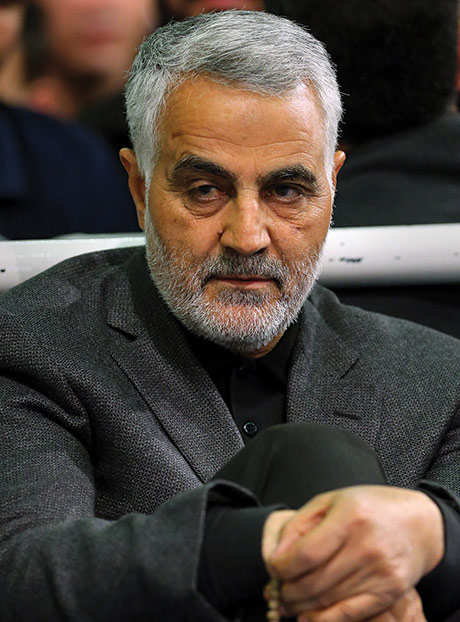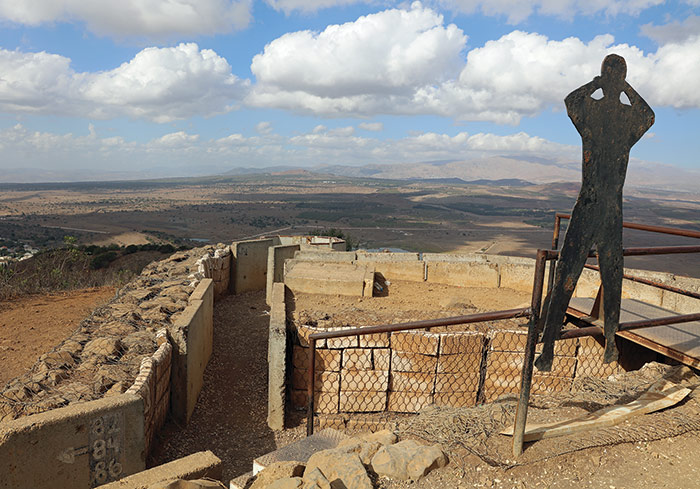The Mabam Strategy: Israel, Iran, Syria (and Russia)
On September 7, 2017, Israeli fighter jets hit a “scientific research center” (in reality, an Iranian weapons facility) in the city of Masyaf in northwest Syria. And so began the next phase of the “campaign between the wars” (known in Hebrew as m’aracha bein ha-milchamot or, more succinctly, by the acronym mabam). Since then, Israel has continued to quietly but decisively counter Iran’s entrenchment in Syria, worked to thwart the activities of its terrorist proxy Hezbollah on the northern border, maintained studied neutrality with regard to the outcome of the long Syrian civil war, and put into place a “deconfliction mechanism”—regular exchanges of information and a protocol when things go wrong—to avoid an unintentional conflict with Russian forces. It’s been a complex operating environment, and it won’t be any easier for the next Israeli government, whether it is led by Bibi Netanyahu or Benny Gantz.

Under the leadership of Major General Qasem Soleimani, commander of its Quds Force, Iran’s aim has been to equip proxies based on Israel’s northern border in Syria and Lebanon, and perhaps in Gaza as well, with advanced missiles. These missiles could serve to deter attacks on Iranian nuclear sites, while a nuclear weapon would eventually give its conventional forces on Israel’s borders the ability to act with impunity. Iran has sought to establish airfields and naval bases in Syria, built several precision missile plants like the one at Masyaf, and imported Shia militias from other countries into Syria so that it can continue operations even after withdrawing most of its own troops. It also continues to attempt to establish a Syrian Hezbollah modeled on the Lebanese version. Israel’s next prime minister will have the complex task of evolving a strategy to prevent new strategic threats from emerging as changing circumstances make the situation even more explosive.
Every Israeli airstrike in Syria carries three major risks: the potential for uncontrolled escalation on the northern front; the possibility of harming Israel’s already tense relationship with Russia; and the danger to Israel’s air force. In 2018, each of these risks was realized to some degree: Iran twice responded to airstrikes by firing missiles at Israel; a Russian plane was downed by the Syrians during an Israeli bombing operation, causing a diplomatic crisis between Moscow and Jerusalem; and an Israeli F-16 was shot down (though, fortunately, its pilot was able to eject over Israeli territory). There is no reason to believe that any of these incidents was a one-off. On the contrary, close observers believe that such risks may grow in the coming months.
With Syrian rebel forces all but vanquished as of this writing, the Iran-led axis will likely have a greater appetite for escalation against Israel. While Syrian forces are still deterred from firing on Israel in any capacity beyond air defense, it is feasible that Iranian and Hezbollah forces will seek to strike Israel from Syrian territory, eliciting a powerful Israeli response, and that could easily lead to a spiraling series of reprisals on both sides. As all military experts know, it is easy for even the most disciplined military to stumble into a full-scale war in such situations. And the risk is not confined to any single military force: With fighters from Syria, Russia, Iran, and Lebanese Hezbollah all operating on Israel’s northern front, an exchange of fire between Israel and any one of these military actors could deteriorate into a battle against all of them, and perhaps even against Iran-backed Hamas in Gaza.
On May 9, 2018, Benjamin Netanyahu was the only Western state guest to attend the military parade on Red Square, but that was before 15 Russian soldiers died when a Russian surveillance plane was downed by Syria’s air defense systems this past September during an Israeli bombing raid on an Iranian target in northern Syria. Netanyahu did return to Russia just last month, in February 2019, to meet again with Putin, who issued a pointed statement that he “hope[d] . . . continuity will be preserved in the development of Russian-Israeli relations,” regardless of the outcome of Israel’s elections. Between these two meetings, however, Russian officials became increasingly hostile in their comments on Israeli activities in Syria, calling them “criminally negligent,” “provocative,” “arbitrary,” and “gross violations of Syrian sovereignty.”
Following the September 2018 downing of the Russian surveillance plane, the Kremlin equipped Syrian air defenses with S-300 surface-to-air missile batteries to enable better defenses against Israel’s air force. If Israeli operations in Syria continue at their present pace and the current trend in Russia-Israel relations persists, the deconfliction mechanism with Russia may not hold up. What could happen if Russia stops cooperating with Israel? Might it employ its own even more advanced S-400 air defense systems to protect Iranian personnel, weapons, or facilities in Syria?
Even if Russia and Israel manage to maintain cordial relations, Jerusalem clearly cannot depend on Moscow to achieve or guarantee its goal of security on the northern border, notwithstanding its posturing as a useful mediator in Syria. As we were drafting this article, Israel struck Quneitra, just 500 feet from the 1974 ceasefire line between Syria and Israel, killing both Iranian and Hezbollah operatives. This February 2019 strike was only the latest reminder that Russia’s promise to distance hostile forces from Israel’s border remains unfulfilled. Meanwhile, the unpredictable nature of the U.S. government’s decision-making process in this arena should make Israeli strategists wary of depending on Washington for anything beyond a green light to strike when necessary and diplomatic support in international forums.

For Israel’s pilots, sorties over Lebanon and into Syria will likely become more dangerous as the Iran-led axis’s antiaircraft capabilities improve. Moscow says that the S-300 batteries it recently delivered to Syria will be operational shortly (though it is not yet clear who will operate them and who will make decisions about how and when they are used).
So far, Iran has not responded in a serious way to Israeli strikes in Syria—because it has not been able to develop an effective operational plan for doing so—but that could change. Indeed, there is considerable danger that Tehran will feel increasing pressure to strike back in order to save face in the lopsided conflict. Such pressure will only grow as Israel becomes more vocal in claiming credit for strikes and more explicit about its goals. It was only this January that outgoing IDF chief of staff Gadi Eizenkot spoke openly of activities on the northern front as a coherent strategy of mabam, in an interview with Bret Stephens in the New York Times. The next month, after the Quneitra strike, Prime Minister Netanyahu said, “We operate every day, including yesterday, against Iran and its attempts to entrench itself in the region.”
But no matter how many Iran-run facilities and Iranian troop positions Israel strikes, it will never be cost effective to remove every Iranian soldier from Syrian soil. Instead Israel should focus on preventing its adversaries to the north from acquiring advanced weaponry and constructing the infrastructure for terror (from underground tunnels to missile batteries) along Israel’s border.
After the next election, Israel’s leaders need to decide if its current strategy is still the best way to keep the country safe from threats along its northern border. More fundamentally, Israel must clearly delineate its strategic goals with regard to Syria, which will be ruled by Bashar al-Assad with the active assistance of Russia and Iran for the foreseeable future. In designing an updated mabam strategy, Israel’s leaders have four strategic options from which to choose.
First, Israel could, of course, simply continue with the current approach, despite its growing risks and the new challenges. Israel could even seek to use the growing possibility of escalation in its favor by highlighting the risks that Iran’s provocations pose to Russia’s interest in stabilizing Syria, which might push Moscow to rein in Tehran.
Second, since 2006, the IDF has adopted a passive approach toward Lebanon that depends on deterrence to avoid war. Israel could deploy this same strategy in Syria, in essence choosing to minimize the immediate risks, particularly the risk of escalation. The advantage of this policy is that, unlike the present mabam, it entails no immediate operational cost or risk of war, but the danger is that the failure of deterrence is “predictable” or explicable only in retrospect—and the cost of war is considerable.
Third, Israel might use technological tools to negate the efficacy of the advanced weaponry being supplied by Iran, in order to prevent missiles from hitting their targets in Israel. For example, Israel’s leaders could decide to fortify the country’s existing missile defense by purchasing additional Iron Dome or Arrow batteries, or the country might develop enhanced disruptive technologies like jammers for use against GPS missile guidance kits. Like deterrence, this approach does not risk escalation, but new technology is both expensive and uncertain. Moreover, any defensive measure can eventually be evaded by an adept enemy.
Finally, rather than continuing with the current piecemeal approach, Israel could launch a comprehensive preemptive strike to destroy all known advanced weapons systems and the facilities used to produce them in Syria. In a single day, Israel could deal a major blow to the Iranian/Hezbollah military build-up and set it back significantly. Of course, if the next Israeli government chooses this tack, war would be a fully expected outcome rather than a possible risk—albeit a war that Israel’s enemies would fight with considerably reduced firepower.
These four strategic options are not mutually exclusive; Israel might adopt elements of all of them as it formulates a new multilayered mabam strategy. For example, Israel could raise the threshold for approval of airstrikes, continue to carry out a smaller number of surgical attacks on targets of the highest priority, and work to develop technology to interfere with the successful operation of precision missiles, while at the same time planning a major strike on the mass production facilities of Iran’s advanced weapons project if and when they approach completion.
Of the many threats facing Israel, Iran’s effort to build major military capabilities in Syria and Lebanon ranks highest in both immediacy and magnitude. The supreme leader of Iran Ayatollah Khamenei has made it abundantly clear that his ultimate goal is not to deter Israel but to destroy it, and his proxy forces and advanced missiles in Syria are on the front lines of those efforts. As always, Israel must balance the need to prevent the emergence of a strategic threat against the importance of avoiding unnecessary escalation.
As the dust settles at what appears to be the end of civil war in Syria, Israel must rethink its strategy and tactics in the “campaign between the wars.” The decisions made over the next year may determine the strategic balance of the region for decades to come. As one of us wrote in these pages four years ago, “Assad’s demise and the collapse of the radical axis is the best strategic outcome Israel could expect.” That, unfortunately, did not come to pass. Israel’s next prime minister must deal with the reality we have, not the reality we hoped for.
Suggested Reading

Why the Kotel Must Be Governed: A Response
Just as soldiers in the IDF have no choice but to eat kosher food, the Jewish state makes decisions as to the nature of its consecrated sites: Jewish decisions.
Letters, Winter 2023
From the Editor: As we were closing this issue, I was, like you, talking with friends about the recent Israeli election—the usual conversations, half potted punditry (at least on my part), half worried banter. When I spoke with JRB editorial board member Hillel Halkin, he surprised, even shocked me. It wasn’t his erudite eloquence that surprised me—Hillel is, after all,…

Unsettling Days
Assaf Gavron’s The Hilltop is a refreshing reminder that traditional realism is still an effective vehicle of insight into contemporary society and politics.

“Wherever You Go, I Will Go”: Reading Ruth 1:16-17
It is traditional to read the book of Ruth on Shavuot. Leon Kass has been reading it with his granddaughter, and the result is a new book.
Comments
You must log in to comment Log In